|
Second Battle of Saltville
Virginia Civil War History
Second Battle of Saltville
Other Names: Battle of Saltville; Battle of the Saltworks; Battle
of Saltville II
Location: Smyth County, Virginia
Campaigns: Stoneman’s Raid into Southwest Virginia (December
1864); Virginia Saltworks Campaign (May-December 1864)
Date(s): December 20-21, 1864
Principal Commanders: Maj. Gen. George Stoneman [US]; Maj. Gen. John C. Breckinridge [CS]
Forces Engaged: Divisions (US 4,500; CS 2,800)
Estimated Casualties: Unknown
Result(s): Union victory
Summary: After defeating
a Confederate force at Marion on December 17-18, 1864, Stoneman’s expedition advanced to Saltville in what
would be the fifth and final battle of the Saltworks Campaign, thus eliminating the major supplier of the Confederacy's
salt — and in four months the war would end. After determined skirmishing on the part of the outnumbered Confederate
defenders, the Virginia Saltworks were overrun and destroyed by Stoneman's cavalry, accomplishing the principal objective
of the raid. The Union cavalry was armed with the next generation weapon called the Spencer carbine, which was merely
a shorter version of the Spencer repeating rifle. Stoneman, the highest ranking Union prisoner-of-war, had superior numbers
compared to the opposing force, so the outcome was quite certain bar a disaster. This was Stoneman's first taste of victory,
because he was said to be "worthless" after his atrocious performance at Chancellorsville, which would become known as Stoneman's
Raid of 1863. Unknown to Stoneman, the saltworks had sustained only superficial damage, and in just two months, Feb. 1865, the
works would be fully operational, but the same could not be said for the trains that were necessary to transport the much
needed tonnage to the Confederate war effort. Two months after Saltville boasted of its return to production, in April '65,
Lee would surrender to Grant, concluding the four year struggle of Civil War.
| Map of the Battle of Saltville, Virginia |
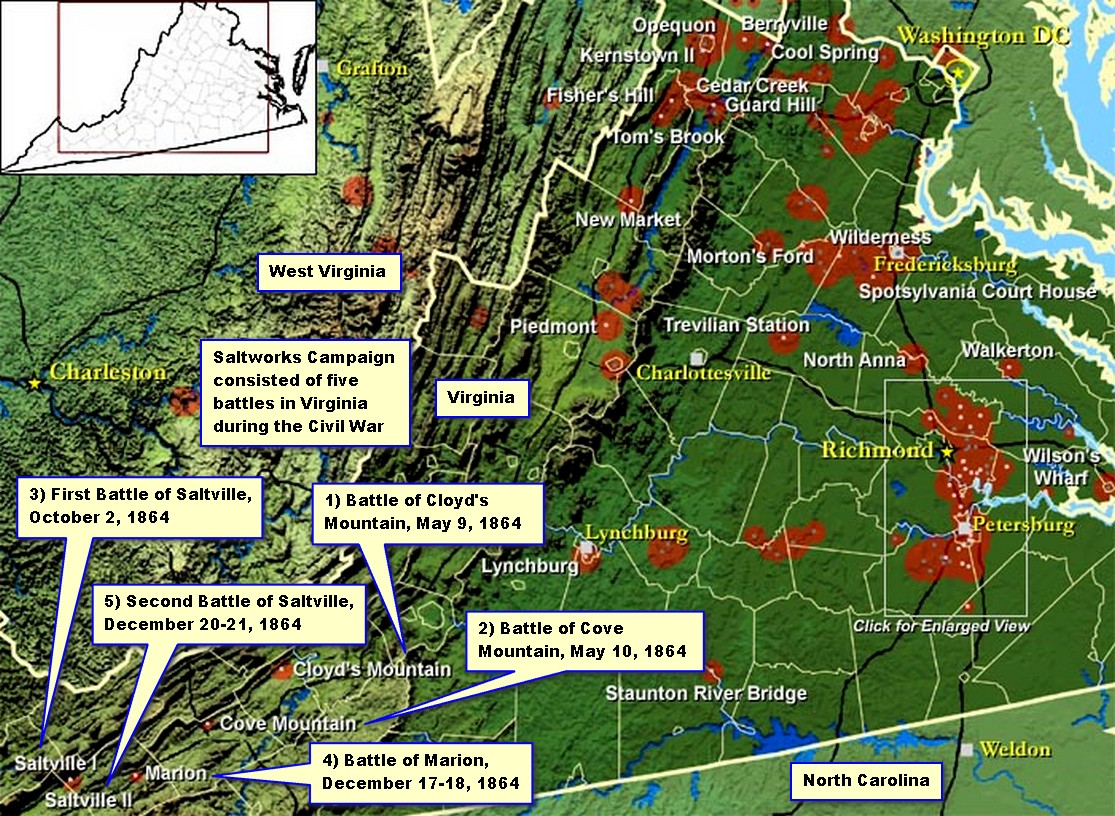
|
| High Resolution Map of Saltworks Campaign and the Battle of Saltville |
| Battle of Saltville, Virginia, and the Saltworks |
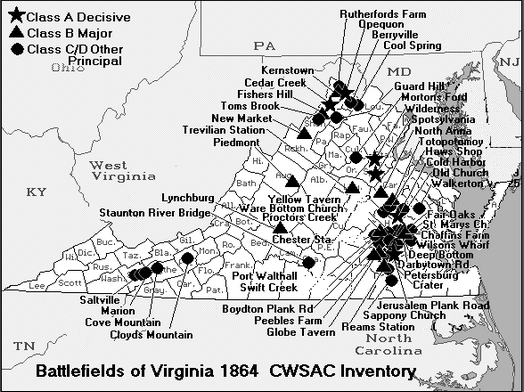
|
| Civil War Battle of Saltville Map |
| Civil War Map of Tennessee Battlefields |
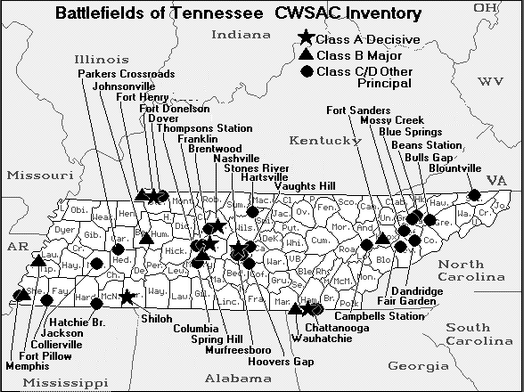
|
| Map of Tennessee Civil War Battles |
Introduction: Southwestern Virginia was important
to the Confederacy though it experienced few battles. The Virginia and Tennessee
Railroad ran through the region, connecting the eastern and western theaters of operation. It also hosted salt and
lead mines that were vital to the Southern war effort. Located in northwestern Smyth County, Virginia, Saltville, during its
peak war year in 1864, manufactured about 4,000,000 bushels — 200,000,000 pounds — an estimated two-thirds of
all the salt required by the Confederacy. No wonder, then, that this remote area found itself in the 1860s thrust into the
very center of military activity in southwestern Virginia as North and South clashed over these vital salt operations. Salt
was necessary for preserving food, for sustaining life itself, and it was an integral part of the leather curing
process. An army may march and fight well on a full stomach, but without leather it would have to do it
with the poorest quality boots and footwear, and absent leather there would be no saddles and the much needed tack for
horses.
At Saltville, the Confederates would put up stiff resistance, but superior numbers and rapid firing carbines
would seal the Union victory. Believing the works fully destroyed, Stoneman's
troops left Saltville and withdrew from southwestern Virginia. But, incredibly, the saltworks had not been permanently disabled.
A report to General Breckinridge a few days after the Saltville engagement said that fewer than two-thirds of the sheds and
less than one-third of the kettles had been destroyed, and that some of the sheds and furnaces were left untouched. Several
weeks later, the furnaces were going once more and salt was again being furnished to the various states until the end of the
war, but due to the immense damage of the railroads in the area, lack of transportation would muzzle the movement of
any significant quantity of salt.
Background: As Stoneman's cavalry fought in the Atlanta Campaign under Maj. Gen. William T. Sherman, he
was captured by Rebel soldiers outside Macon, at Clinton, on July 31, 1864, becoming the highest ranking Union prisoner-of-war.
He was transferred to Charleston, South Carolina, where he remained a prisoner for three months, until October, when he was
exchanged by the Confederacy at the personal request of Sherman. After Stoneman was exchanged and released from the Confederate
prison, Stanton and Grant both ordered him relieved from duty, but Maj. Gen. John Schofield, commanding Department of Ohio, intervened
and persuaded the two to countermand their joint order. Maj. Gen. Stoneman was now commanding cavalry, Department of Ohio,
and was leading his troopers from the Union stronghold in East Tennessee, where he would be assigned for the remainder of
the Civil War. Immediately after being released from prison, Stoneman sought permission of Schofield to lead
a raid against the Virginia & Tennessee Railroad and the saltworks of Saltville, Virginia. "I owe the Southern Confederacy
a debt I am anxious to liquidate, and this appears a propitious occasion,” said Stoneman as he reflected on his
stint in a Confederate prison.
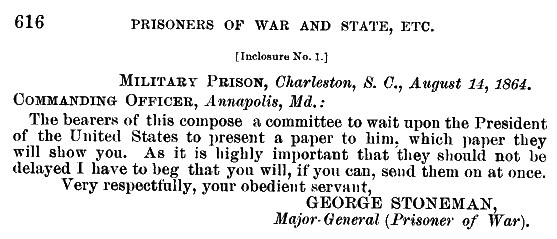
While assigned to the Dept. of Ohio and prior to the Saltville raid, Stoneman had
oft times conversed with longtime friend and Ohioan John Schofield, who saw what others had not in the tall, confidant
cavalryman- a risk taker who never said no to a fight. The Union Army was full of generals who had the ability to fight,
but to take risks on the battlefield when opportunities permitted, well, that sort was lacking. It was Schofield who
persuaded both Stanton and Grant to dismiss without prejudice the orders to relieve Stoneman, and it was Schofield who granted
Stoneman his desire for the assault on the much needed Confederate saltworks in Virginia. Stoneman submitted his plan of battle
for Saltville to Schofield, who slightly amended it before granting permission.
Battle: The Second Battle of Saltville, the fifth and final
battle of the Saltworks Campaign, was fought during December 20-21, 1864.
During the actions of the Saltworks Campaign, Brig. Gen. Crook was
unable to push his large force into or near the salt facilities during the Battle of Cloyd's Mountain, May 9, 1864, and at the Battle of Cove Mountain, May 10, 1864, Brig. Gen. Averell was repulsed by brigadiers John Hunt
Morgan and William E. Jones, and while in the First Battle of Saltville, October 2, 1864, Brig. Gen. Burbridge committed a series of blunders, thus
causing his rout. The Battle of Marion, December 17-18, 1864, saw Maj. Gen. Stoneman destroy a portion of the
lead mines and salt ponds before turning his large force to Saltville, where the final destruction of the Saltworks occurred
during December 20-21, 1864.
General George Stoneman led the Union forces consisting of Gen. A.C. Gillem’s
men, Gen. Stephen Burbridge’s Kentucky battalions, and the 5th and 6th United States Colored Cavalry (which had been
repulsed with heavy losses in the First Battle of Saltville just two month prior) and the 10th Michigan Cavalry on
a raid on Saltville on December 20, 1864. The Union army had as many as 5,000 men according to contemporary reports, while
more modest accounts place the total closer to 4,500. The Federal objective was rather simple in theory, Stoneman was
to accomplish what Burbridge had attempted two months earlier in October, only to limp off the scene with
staggering losses. Stoneman was to destroy the salt capitol of the Confederacy.
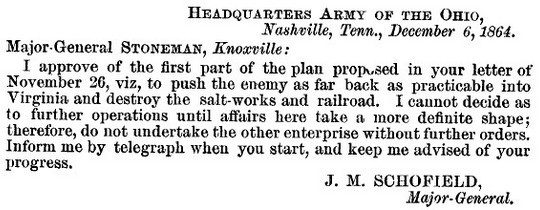
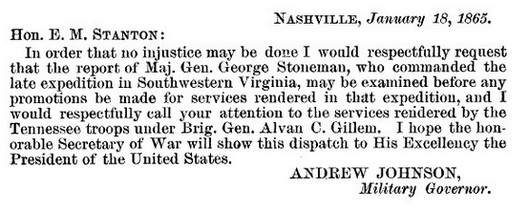
Though Stoneman had just thrashed
the Confederate garrison at nearby Marion just days prior, the defeated but determined Gen. Breckinridge reformed
his patchwork command and was now in pursuit of the Union troops. Gen. John C. Breckinridge, a former Vice President
of the United States and the highest U.S. public official to commit treason, ordered one column to take the
road to the left into Rye Valley, but this route proved problematic, as the company lost their way several times during the
nighttime passage. In the morning, the company continued down the mountain into Rye Valley, and turned up the valley, and
marched throughout the day, ending at Mount Airy, on the Wytheville and Marion road.
Two roads led into Saltville: the Glade Spring road lay to the southwest,
and the Lyon’s Gap road led from the southeast. Three hills a mile out of Saltville barricaded the convergence of these
two roads. On these hills, protecting these roads the Confederates had constructed two forts, Fort Breckinridge (sometimes
spelled Breckenridge) to protect Glade Spring and Fort Statham to guard Lyon’s Gap. Colonel Robert Preston was
stationed in Saltville with 500 men, charged with protecting these two fortifications. With him was Captain John Barr, who
commanded the artillery. With these limited resources, Colonel Preston picketed both roads to try and meet the approaching
Union troops.
Gen. Basil Duke with a detachment, who had traveled from Abingdon along
the Saltville road, and Captain Tom Barrett with men from the 4th Kentucky mounted rifles were also en route to Saltville
to head off the coming raid. By the time Breckinridge’s forces reached Preston mansion at Seven Mile Ford on the outskirts
of Saltville on the evening of the 20th of December, Duke and Captain Calvin Morgan were already there, watching Saltville
burn.
Gen. Gillem reached Saltville
first, attacking Colonel Preston’s pickets on the Glade Spring road. Shortly after, Gen. Burbridge’s men attacked
at the Lyon’s Gap road. The Union forces crested both Fort Statham and Fort Breckinridge, and moved down into the town
and descended upon the Saltworks. Colonel Preston called the surviving members of his reserves into retreat, and evacuated
the town. The Federal soldiers destroyed 1000 of 3000 boiling kettles and burned a number of the evaporating sheds before
moving on to rip up sections of the nearby Virginia and Tennessee railroad. They failed however to damage any of the actual
salt wells, and the remaining kettles and sheds were sufficient to continue the needed salt production until the end of the
war.
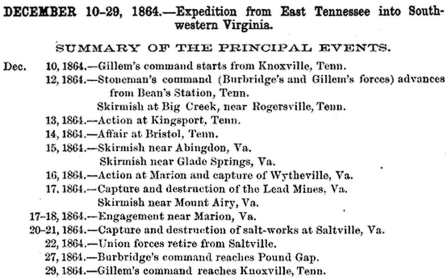
After the raid, Stoneman and Gillem fell back to Tennessee, while Burbridge
retreated through Pound Gap and into Kentucky.
Analysis: Salt
played a major role during the Civil War. Salt not only preserved food in the days before refrigeration, but was also vital
in the curing of leather. Union general William Tecumseh Sherman once said that "salt is eminently contraband," as an army
that has salt can adequately feed its men.
The most important saltworks for the Confederacy were nestled at Saltville,
Virginia. In late 1864, the Union army twice advanced to capture and lay waste of the works, as it was the last prominent
source of salt for the eastern Confederate states. In October 1864, during the First Battle of Saltville, the Confederate
army easily repulsed the Union assault, but merely two months later in December,
during the Second Battle of Saltville, Union forces under George Stoneman managed to destroy the vital saltworks — at
least temporarily. But in actuality, many of the crucial components of the works went unscathed. Two months after
Stoneman had trekked and trashed the saltworks, they were operational and partially meeting the demands of the Confederacy,
but the destroyed railroad system around the area hampered its distribution.
On Oct. 2, 1864, Union Gen. Burbridge was repulsed during an ill-fated
attempt to sack the saltworks, but Gen. George Stoneman would accomplish the objective just a few months later in December.
While engaging the much larger Union army, the defending Confederates
were at a great disadvantage for another reason during the two day fight, because armed with the single-shot, muzzle-loading Springfield rifle-musket, each soldier, though a veteran of many bloody battles,
needed to steady his hands to complete the lengthy reloading process of the musket. While the Southerner would reload,
take aim, fire, and repeat the cumbersome process, his rate of fire was 3 or at best 4 rounds per minute. Facing Johnny Reb
at the works was Billy Yank, who was now sporting the next generation Spencer carbine, which enabled Stoneman's
veteran cavalrymen a rate of fire of 21 rounds per minute. The carbine, also with a tube holding 7 cartridges, was
similar to the Spencer repeating rifle but had a shorter barrel for easier handling while on horseback. Not the luck
of the Irish, but greater numbers and superior weapons won the battle of Saltville for the veteran horsemen. (See
also Civil War Weapons, Small
Arms, Firearms, and Edged Weapons and Civil War Weapons, Firearms, and Small Arms,)
Although Maj. Gen. George Stoneman was enjoying the success of his first victory
after 3 years and 9 months of grueling Civil War, and only 3 months and 3 weeks prior to Lee surrendering to Grant, he had recently
been ranked among the Union's who's who of worst performing commanders to date. A rather disparaging title that
made the 6'4" cavalry commander the joke among Washington's elite. But Stoneman, never refusing battlefield risks
and never crawfishing from an opportunity to fight ole Johnny Reb, had said only a few months prior to the Saltville
battle, that "if given the change he was going to lick the Rebel command under Breckinridge!"
But the New Yorker Stoneman was pronounced a loathsome commander and
was considered one of the most worthless soldiers in the Union service, according to Secretary of War Stanton.
Gen. Hooker had said that Stoneman's horrid performance was primarily to blame for the Federal loss at Chancellorsville
in May of 1863. Gen. U.S. Grant had even co-sponsored, with Stanton, the orders relieving Stoneman not only of his
command but forever of the Union blue after he became a prisoner-of-war causing quite a stir in Northern papers as well as much
embarrassment to his superiors who were already sorely displeased with the cavalry commander's performance.
| Battle of Saltville History |
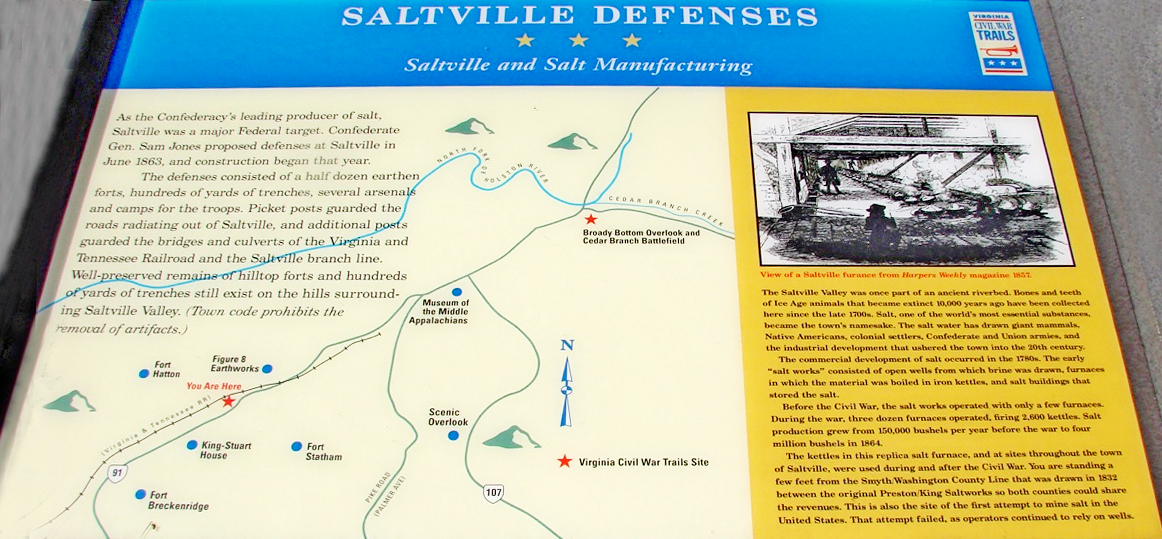
|
| Saltville Defenses during the Civil War |
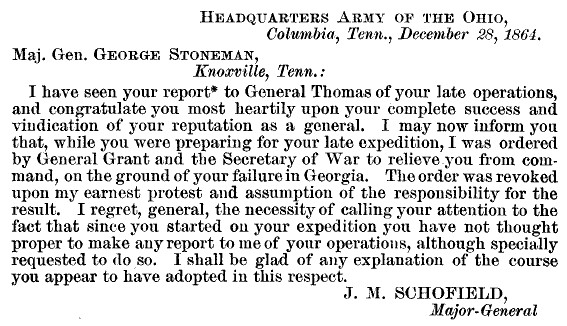
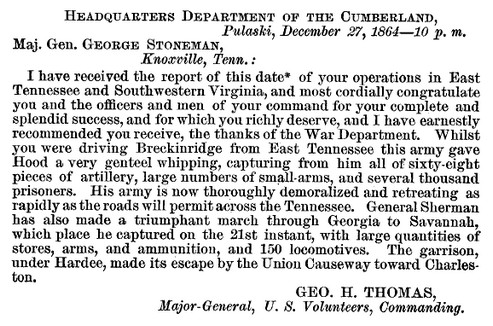
“I might as well have had a wet shirt in command of my cavalry,”
Hooker had said about Stoneman at Chancellorsville. “I think him one of the most worthless officers in the service
and who has failed in everything entrusted to him,” said Stanton. If the already disconcerting monikers assigned to
Stoneman weren't rife enough, the next move would secure himself a record that would forever be etched
in the annals of Civil War history.
"I would like to try it and am willing to run any risk," said Stoneman to
Gen. Sherman prior to his ride toward Andersonville prison in "an attempt to free the men there." But instead
Stoneman soon found himself in a Confederate prison in Charleston, S.C., and would now be known as the highest ranking Union
officer to become a prisoner-of-war. His plan was just another of many failed actions by the beleaguered Northerner. But Sherman
negotiated with Confederate authorities and secured the release of Stoneman after he served three months in the Palmetto prison,
and Schofield during this time persuaded Grant and Stanton to countermand their orders relieving Stoneman of military service.
While Stoneman's military career had been a foregone conclusion, someone
merely forgot to inform the major general because upon release from the Confederate prison, Gen. John Schofield
intervened on Stoneman's behalf and had him assigned as his cavalry commander for the Army of Ohio. There is little doubt
that Stoneman felt that he had a debt to repay to Schofield for his continuing friendship and interventions during the
war. He was determined to show his appreciation to his dear friend by initially destroying the saltworks of Saltville,
but Stoneman had another excursion in mind, one that would make western North Carolina and southwestern Virginia howl. Today,
Stoneman is known largely for his punishing raid of several Southern states in 1865, in addition to the destruction of the
saltworks.
(Sources and related reading
are listed below.)
Recommended
Reading: Lee's Endangered Left: The Civil War In Western Virginia, Spring Of 1864. From Kirkus Reviews: A competent, well-executed addition to the
ever-growing horde of Civil War literature, by Duncan (History/Georgetown University). The author reconsiders Union General
Ulysses S. Grants attempts to destroy the Confederates, led by General Robert E. Lee, at their traditional stronghold in western
Virginia and his efforts to threaten Lynchburg
during the spring and summer of 1864. Continued below…
The writing
here is crisp; refreshingly, our chronicler pays sharp attention to the effects of the campaign on civilians as the Union
army penetrated beyond its supply lines and came to live off the countryside in one of the Confederacy’s richest agricultural
regions, bringing home the harsh realities of war to civilians. The campaign swung back and forth, with Northern victories
at Cloyd's Mountain and New
River Bridge and Confederate routs at New Market, followed by a Union
failure to seize Lynchburg. Though the campaign proved costly
to the South, overall the Unions hope to capture the Shenandoah Valley foundered and the Confederates then went on to threaten
Washington, D.C. Duncan sensitively employs a wide variety of sources, military and civilian, to add to the coherence of his
account. Still, the books scope remains narrow, focusing on a not terribly glamorous period in the wars history; then, too,
wed do well to have the volume trimmed by a third. Duncan’s contention that the Unions
severity in dealing with civilian populations was directly reciprocated when the Confederates took Chambersburg,
Penn., creating a chain of vengeance that culminated when Sherman marched through the South, is insightfully argued, offering a fresh analysis to the
historical debate. Casual readers of the Civil War genre (and many die-hard buffs, as well) may want to leave this superbly
researched yet ultimately too specialized study for the historians to ponder. Includes 20 photographs.
Recommended
Reading: Saltville Massacre (Civil War Campaigns
and Commanders). Description: In October 1864, in the mountains of southwest Virginia,
one of the most brutal acts of the Civil War occurs. Brig. Gen. Stephen Burbridge launches a raid to capture Saltville. Included
among his forces is the 5th U.S. Colored Cavalry. Repeated Federal attacks are repulsed by Confederate forces under the command
of Gen. John S. Williams. Continued below…
As the sun
begins to set, Burbridge pulls his troops from the field, leaving many wounded. In the morning, Confederate troops, including
a company of ruffians under the command of Captain Champ Ferguson, advance over the battleground seeking out and killing the
wounded black soldiers. What starts as a small but intense mountain battle degenerates into a no-quarter, racial massacre.
A detailed account from eyewitness reports of the most blatant battlefield atrocity of the war.
Recommended Reading:
Saltville (VA) (Images of America), by Jeffrey C. Weaver (Author), The Museum
of the Middle Appalachians (Author): Description: Saltville, Virginia, lies on the banks of the North Fork of the Holston
River on the border between Smyth and Washington Counties. Its history began very long ago; in fact, archeological evidence
suggests extensive human habitation there for more than 14,000 years. Saltville was named because it was a source of salt,-and
by the end of the 18th century, a thriving industry was born. During the Civil War, Saltville attained considerable importance
to the Confederate government as a supply of salt. Continued below…
A large Confederate
army garrison was maintained there, and extensive fortifications were constructed. After the Civil War, the town led the way
in industrialization of the South. Flip through the pages of Images of America: Saltville to learn why Saltville is one of
the most historic places in the world. About the Author: The Museum of the Middle Appalachians, located on Palmer Avenue
in Saltville, was established by the Saltville Foundation in the 1990s. It has become the repository for fossils, artifacts,
and photographs of the region. Author Jeffrey C. Weaver holds degrees in American history from Appalachian State University,
and after serving in the U.S. Army for several years, he worked as a contracting officer for the U.S. Department of Energy.
He is currently the manager of the Chilhowie Public Library.
Recommended Reading: Three Days in the Shenandoah: Stonewall Jackson at Front Royal and Winchester (Campaigns and Commanders) (Hardcover).
Description: The battles of Front Royal and Winchester are
the stuff of Civil War legend. Stonewall Jackson swept away an isolated Union division under the command of Nathaniel Banks
and made his presence in the northern Shenandoah Valley so frightful a prospect that it triggered
an overreaction from President Lincoln, yielding huge benefits for the Confederacy. Continued below…
Gary Ecelbarger
has undertaken a comprehensive reassessment of those battles to show their influence on both war strategy and the continuation
of the conflict. Three Days in the Shenandoah answers questions that have perplexed historians for generations. About the
Author: Gary Ecelbarger, an independent scholar, is the author of Black Jack Logan: An Extraordinary Life in Peace and War
and "We Are in for It!": The First Battle of Kernstown, March 23, 1862.
Recommended
Reading: Shenandoah 1862: Stonewall Jackson's Valley Campaign, by Peter Cozzens (Civil War America)
(Hardcover). Description: In the spring of 1862, Federal troops under the command of General George B. McClellan launched
what was to be a coordinated, two-pronged attack on Richmond
in the hope of taking the Confederate capital and bringing a quick end to the Civil War. The Confederate high command tasked
Stonewall Jackson with diverting critical Union resources from this drive, a mission Jackson fulfilled by repeatedly defeating
much larger enemy forces. His victories elevated him to near iconic status in both the North and the South and signaled a
long war ahead. One of the most intriguing and storied episodes of the Civil War, the Valley Campaign has heretofore only
been related from the Confederate point of view. Continued below…
With Shenandoah
1862, Peter Cozzens dramatically and conclusively corrects this shortcoming, giving equal attention to both Union and Confederate perspectives.
Based on a multitude of primary sources, Cozzens's groundbreaking work offers new interpretations of the campaign and the
reasons for Jackson's success. Cozzens also demonstrates instances
in which the mythology that has come to shroud the campaign has masked errors on Jackson's
part. In addition, Shenandoah 1862 provides the first detailed appraisal of Union leadership in the Valley Campaign, with
some surprising conclusions. Moving seamlessly between tactical details and analysis of strategic significance, Cozzens presents
the first balanced, comprehensive account of a campaign that has long been romanticized but never fully understood. Includes
13 illustrations and 13 maps. About the Author: Peter Cozzens is an independent scholar and Foreign Service officer with the
U.S. Department of State. He is author or editor of nine highly acclaimed Civil War books, including The Darkest Days of the
War: The Battles of Iuka and Corinth (from the University
of North Carolina Press).
Recommended
Reading: Shenandoah Summer: The 1864 Valley Campaign. Description: Jubal A. Early’s disastrous battles in the Shenandoah Valley
ultimately resulted in his ignominious dismissal. But Early’s lesser-known summer campaign of 1864, between his raid
on Washington and Phil Sheridan’s renowned fall campaign, had a significant impact on the political and military landscape
of the time. By focusing on military tactics and battle history in uncovering the facts and events of these little-understood
battles, Scott C. Patchan offers a new perspective on Early’s contributions to the Confederate war effort—and
to Union battle plans and politicking. Patchan details the previously unexplored battles at Rutherford’s Farm and Kernstown
(a pinnacle of Confederate operations in the Shenandoah Valley) and examines the campaign’s
influence on President Lincoln’s reelection efforts. Continued below…
He also provides
insights into the personalities, careers, and roles in Shenandoah of Confederate General John C. Breckinridge, Union general
George Crook, and Union colonel James A. Mulligan, with his “fighting Irish” brigade from Chicago.
Finally, Patchan reconsiders the ever-colorful and controversial Early himself, whose importance in the Confederate military
pantheon this book at last makes clear. About the Author: Scott C. Patchan, a Civil War battlefield guide and historian, is
the author of Forgotten Fury: The Battle of Piedmont, Virginia, and a consultant and contributing writer for Shenandoah, 1862.
Review
"The author's
descriptions of the battles are very detailed, full or regimental level actions, and individual incidents. He bases the accounts
on commendable research in manuscript collections, newspapers, published memoirs and regimental histories, and secondary works.
The words of the participants, quoted often by the author, give the narrative an immediacy. . . . A very creditable account
of a neglected period."-Jeffry D. Wert, Civil War News (Jeffry D. Wert Civil War News 20070914)
"[Shenandoah
Summer] contains excellent diagrams and maps of every battle and is recommended reading for those who have a passion for books
on the Civil War."-Waterline (Waterline 20070831)
"The narrative
is interesting and readable, with chapters of a digestible length covering many of the battles of the campaign."-Curled Up
With a Good Book (Curled Up With a Good Book 20060815)
"Shenandoah
Summer provides readers with detailed combat action, colorful character portrayals, and sound strategic analysis. Patchan''s
book succeeds in reminding readers that there is still plenty to write about when it comes to the American Civil War."-John
Deppen, Blue & Grey Magazine (John Deppen Blue & Grey Magazine 20060508)
"Scott C. Patchan
has solidified his position as the leading authority of the 1864 Shenandoah Valley Campaign with his outstanding campaign
study, Shenandoah Summer. Mr. Patchan not only unearths this vital portion of the campaign, he has brought it back to life
with a crisp and suspenseful narrative. His impeccable scholarship, confident analyses, spellbinding battle scenes, and wonderful
character portraits will captivate even the most demanding readers. Shenandoah Summer is a must read for the Civil War aficionado
as well as for students and scholars of American military history."-Gary Ecelbarger, author of "We Are in for It!": The First
Battle of Kernstown, March 23, 1862 (Gary Ecelbarger 20060903)
"Scott Patchan
has given us a definitive account of the 1864 Valley Campaign. In clear prose and vivid detail, he weaves a spellbinding narrative
that bristles with detail but never loses sight of the big picture. This is a campaign narrative of the first order."-Gordon
C. Rhea, author of The Battle of the Wilderness: May 5-6, 1864 (Gordon C. Rhea )
"[Scott Patchan]
is a `boots-on-the-ground' historian, who works not just in archives but also in the sun and the rain and tall grass. Patchan's
mastery of the topography and the battlefields of the Valley is what sets him apart and, together with his deep research,
gives his analysis of the campaign an unimpeachable authority."-William J. Miller, author of Mapping for Stonewall and Great
Maps of the Civil War (William J. Miller)
Sources: National Park Service; Official
Records of the Union and Confederate Armies; Library of Congress; National Archives; Scott C. Patchan, Shenandoah Summer:
The 1864 Valley Campaign, 2009; Richard R. Duncan. Lee's Endangered Left: The Civil War In Western Virginia, Spring Of 1864
(Hardcover), 1999; Thomas D. Mays. Saltville Massacre, 1998; Jeffrey C. Weaver. Saltville (VA) (Images of America), 2006;
Graham MacGregor. Salt, Diet and Health. Cambridge University Press, 1998; Frances Kennedy. The Civil War Battlefield Guide,
1998; David Heidler. Encyclopedia Of The American Civil War; Angela M. Dautartas, C. Clifford Boyd, Rhett B. Herman, Robert
C. Whisonant. Battles of Saltville: October 2nd, 1864 and December 20th, 1864 (2005).
|

